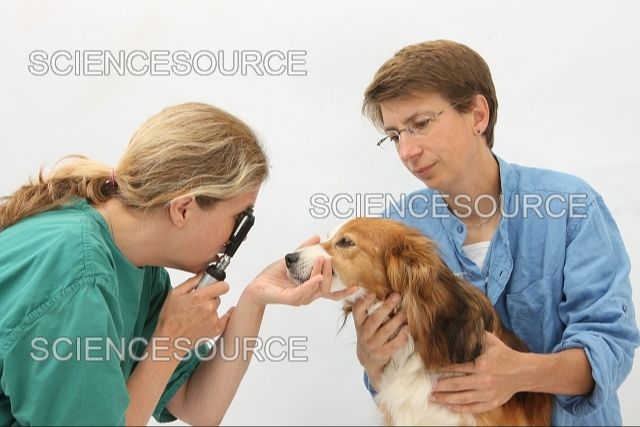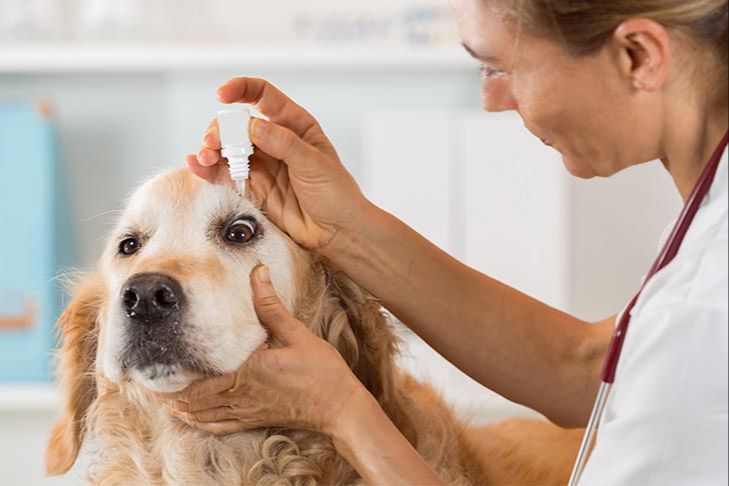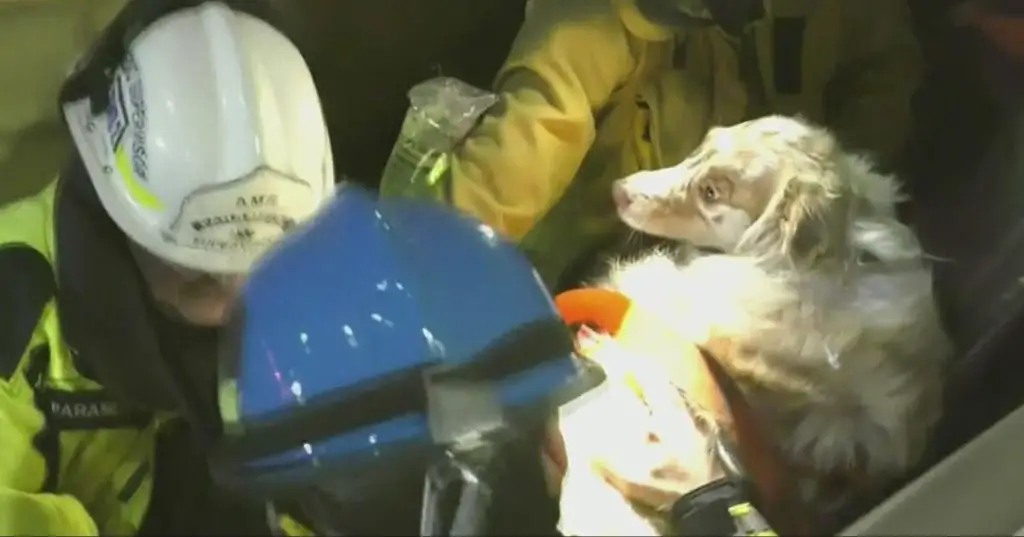What is the third eyelid in dogs?
The third eyelid, also called the nictitating membrane, is a protective layer of tissue located in the inner corner of a dog’s eye. It functions as an extra barrier that sweeps across the eye to keep it moist and protect it from debris and damage 1. Unlike humans, dogs have a third eyelid in addition to an upper and lower eyelid.
The purpose of the third eyelid is to provide additional lubrication and protection for the eye. It contains the tear duct that produces a portion of the tear film covering the eye. The third eyelid helps spread tears across the eye and contains immune cells that protect against infection. It also provides an extra layer to shield the eye from scratches or trauma.
The third eyelid is normally only visible when it sweeps horizontally across the eye to moisten and protect it. If the third eyelid is consistently visible or protruding from the eye, it could indicate an underlying health issue that requires veterinary attention.
Common causes of third eyelid showing

There are several potential causes for a dog’s third eyelid to show, including:
Illness: Diseases like distemper, tetanus, and autoimmune disorders can cause the third eyelid to be visible. The illness may make the eye sink back into the socket, pulling the third eyelid up.1
Eye irritants or infections: Allergies, dry eye, glaucoma, conjunctivitis, inflammation and ulcers can all irritate the eye and surrounding area. This may cause spasms in the third eyelid muscle or retraction of the eyeball.2
Foreign bodies: Something stuck in the eye like dirt, seeds or grass can trigger the third eyelid to protectively cover part of the eye.
Facial nerve paralysis: Damage to the facial nerve controlling the eyelids can cause the third eyelid to be constantly exposed. This may occur due to injury, stroke or other nerve issues.
Problems with the tear duct: Blocked or inflamed tear ducts prevent proper drainage, leading to eye irritation that may expose the third eyelid.
Allergies: Allergic reactions to pollen, mold, dander or other irritants can cause inflammation and swelling of the conjunctiva, surrounding the eyeball and potentially displacing it enough to show the third eyelid.
Diagnosing the cause
If your dog’s third eyelid is showing, it’s important to get a proper diagnosis from your veterinarian. The vet will perform a full physical exam and eye examination to look for potential causes. Some diagnostic tests the vet may use include:
- Eye stain test – Fluorescein dye is applied to the eye to check for ulcers or other irritation
- Allergy testing – Blood tests or intradermal skin testing to check for environmental allergies
- MRI or CT scan – Imaging to check for issues like an eye injury, tumor, or glaucoma
- Biopsy – Taking a tissue sample of the third eyelid for analysis
Your vet will also ask about your dog’s medical history and any recent incidents that could have led to third eyelid exposure. Based on the exam and test results, they can determine the underlying cause and recommend proper treatment. Some common causes include eye infections, eye trauma, glaucoma, ectropion, entropion, and corneal ulcers. Getting an accurate diagnosis is crucial before proceeding with any treatment.
According to Conditions of the Third Eyelid Factsheet – VetSpecialists, advanced imaging like MRI can be useful for identifying tumors or other internal issues causing third eyelid exposure.
Treatment Options
There are several treatment options that may be prescribed by a vet to address the underlying cause of third eyelid issues in dogs:
Medications
Oral antibiotics or anti-inflammatory drugs may be prescribed for 5-10 days to reduce swelling and fight infection. Common medications include doxycycline, cephalexin, meloxicam, or carprofen.
Eye Drops

Antibiotic and/or anti-inflammatory eye drops or ointments containing drugs like neomycin, polymyxin B, dexamethasone, or prednisolone can be applied to the eye for 7-10 days to control inflammation and prevent secondary infections (VetSpecialists).
Flushing Tear Ducts
If tear production is inadequate, the vet may recommend flushing the tear ducts. This can remove debris and help stimulate tear production.
Removing Foreign Objects
Any foreign material trapped under the third eyelid will need to be removed by the vet. This provides immediate relief.
Allergy Management
For dogs with environmental allergies causing third eyelid inflammation, the vet may recommend medications or supplements to reduce allergic reactions. Keeping the dog away from known triggers can also help.
When to see the vet
Persistent third eyelid showing, especially when accompanied by other symptoms like eyelid spasms, swollen/red eyes, or discharge, warrants a veterinary visit. According to PetHelpful, the third eyelid can be an indicator of an underlying condition or irritation in the eye. If the third eyelid does not go away within a day or two, it’s best to schedule a vet appointment.
Some specific situations when you should take your dog to the vet immediately include:
- The third eyelid is covering a large portion of the eye
- The eye appears swollen, red, or inflamed
- There is discharge or crusting around the eye
- The dog is squinting or pawing at the eye
- The eyelids are spasming uncontrollably
Veterinary examination can help diagnose the cause and rule out any serious conditions like glaucoma, corneal ulcers, or trauma to the eye. Early treatment can prevent vision loss or further damage. Your vet may prescribe medicated eye drops, ointments, oral medication, or other therapies depending on the specific condition affecting your dog’s third eyelid.
Caring for dogs with third eyelid issues
Proper care is essential for dogs with third eyelid problems to promote healing and prevent further irritation. Here are some tips for caring for dogs with issues related to the third eyelid:
Keep the eye clean. Use a soft, damp cloth to gently wipe away any discharge coming from the eye. Do this several times a day to prevent buildup. Avoid rubbing the eye.
Prevent rubbing and scratching. Dogs may try to scratch or rub their eyes if they are irritated. Use an Elizabethan collar to prevent this, which will allow the eye to heal. You can also distract your dog with toys or chews.

Carefully administer any prescribed eye medications. Follow your vet’s instructions carefully regarding dosage and timing of any eye drops, ointments or pills. Be sure to finish the entire course of treatment.
Monitor for changes. Watch for increased redness, swelling or discharge which may indicate infection. Contact your vet if the condition seems to worsen or not improve within a few days. Also watch for any behavioral changes like lethargy or loss of appetite.
Be patient during the healing process. It may take a week or more for some third eyelid conditions to fully resolve. Provide ample rest and avoid stimulating activities until your vet gives the all clear.
With proper care under veterinary guidance, most third eyelid problems can be treated successfully. Be vigilant and follow all recommendations to help your dog recover comfortably.
Preventing Third Eyelid Problems
There are several steps dog owners can take to help prevent issues with the third eyelid protruding:
Avoid Eye Irritants
Keeping the dog’s eyes free of irritants is important. Don’t let shampoo or water get in the eyes during bathing. Rinse the dog’s face after going outside to wash away pollen, dirt or debris that could get in the eyes. Avoid letting the dog stick its head out the window when driving, as the wind can blow particles into the eyes.
Manage Allergies
Allergies are a common cause of third eyelid protrusion. Keeping the dog away from known allergy triggers can help minimize eye irritation and swelling. Giving antihistamines as prescribed by the vet can also help control allergic reactions affecting the eyes.
Provide Eye Protection
When going outside on sunny or windy days, put dog goggles or sunglasses on your pet to shield its eyes. This prevents dust and UV rays from irritating the eyes. Discourage your dog from rubbing its eyes excessively, which can cause trauma.
Outlook and prognosis
The outlook and prognosis for a dog’s third eyelid issue depends on the underlying cause. Some minor causes may resolve on their own without treatment, while other more serious conditions require ongoing management and care.
If the cause is an irritation or allergy that can be treated, the third eyelid protrusion will likely resolve once the allergen or irritant is removed. For conditions like Horner’s syndrome or facial nerve paralysis, the outlook can be good with proper supportive care and treatment of any underlying illness (VCAAnimalHospitals.com).
However, certain eye conditions or facial tumors may require surgery and lifelong management. Without treatment, some causes of third eyelid protrusion like glaucoma can potentially lead to vision loss or blindness. That’s why it’s important to have a veterinary ophthalmologist examine any persistent third eyelid issues.
With prompt diagnosis and appropriate treatment tailored to the specific cause, many dogs with third eyelid problems can have a good quality of life. Consult your veterinarian for an accurate prognosis based on your dog’s particular condition.
When to be concerned
There are certain signs related to the third eyelid that warrant urgent veterinary attention. These include:
- Eyelid swollen shut – Swelling that causes the eyelid to be completely closed off indicates a serious problem like infection, tumor, or trauma. This requires rapid treatment to avoid permanent damage.
- Signs of eye infection – Discharge, redness, pain, and squinting can signify infection. Infections left untreated can spread quickly and cause vision loss.
- Persistent third eyelid spasms – If the membrane keeps blinking up repeatedly, it suggests an underlying neurological issue or severe irritation. Diagnostic testing is needed.
- Vision loss – Any sudden loss of vision combined with third eyelid abnormalities could signal a detached retina or other emergency. Immediate vet exam is essential.
In these instances, do not wait to see if the third eyelid retreats on its own. Call your vet right away or go to an emergency animal hospital. Timely treatment gives the best chance of preserving eyesight and preventing lasting damage.
What to do in an emergency
If your dog’s third eyelid is swollen shut, causing complete closure of the eye, seek emergency veterinary care right away. Eye injuries like corneal ulcers or penetrating wounds also require immediate vet attention to prevent vision loss. Some other emergency signs that warrant an urgent vet visit include:

- Sudden, complete third eyelid protrusion covering the entire eye
- Third eyelid stuck in a protruded position and unable to retract
- Red, painful, swollen third eyelid
- Eyelid torn or lacerated
- Pus or bleeding from the eye
- Loss of vision
Bring your dog to the vet or emergency animal hospital without delay if you notice any of these alarming third eyelid issues. Rapid veterinary assessment and treatment is critical to save your dog’s vision and prevent permanent eye damage. In an emergency, don’t attempt home remedies or wait for the situation to resolve on its own. Protect your dog’s long-term eye health by seeking prompt medical care.
